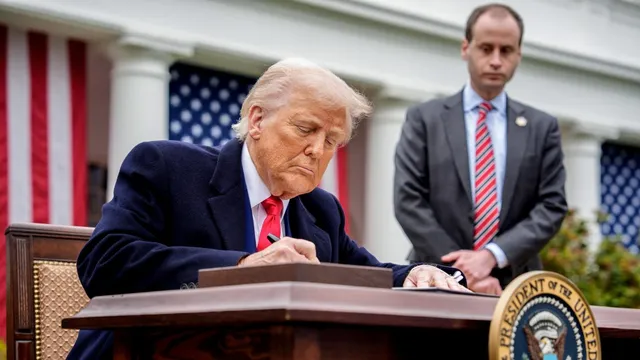
Trump escalates trade war to combat foreign tech regulations
2025-04-03 00:00- In early 2019, Donald Trump initiated policies aimed at addressing restrictive trade practices affecting U.S. tech firms abroad.
- Mark Carney's political aspirations in Canada are revitalized amid Trump's trade war, impacting the political landscape.
- The evolving trade dynamics between the U.S. and foreign nations raise questions about the future of tech regulations and international relations.
Express your sentiment!
Insights
In recent months, the trade dynamic between the United States and its counterparts has shifted significantly. With Donald Trump at the helm, the U.S. government responded to perceived threats posed by foreign regulations, especially those impacting American technology firms. In early 2019, President Trump initiated policies aimed at addressing Digital Service Taxes enacted by various trading nations. These measures were seen as obstacles that hindered the performance of U.S. tech companies in international markets. Additionally, Trump's administration recognized the interconnected nature of these regulations and their potential adverse effects on U.S. firms. Through executive memoranda, Trump voiced concerns over international practices that were labeled as extortionate fines and taxes, outlining a strategy to counter what he perceived as unfair treatment of American companies in the global marketplace. Concurrently, the political landscape in Canada has undergone notable changes, largely influenced by Trump's trade policies. Mark Carney, a prominent figure in Canadian politics and former central banker, has found his aspirations to climb the political ladder unexpectedly revived. As Trump's trade war unfolded, it significantly altered the trajectory of Canada's political scene, providing an opportunity for Carney to emerge as a potential leader in a disrupted political environment. This shifting landscape has challenged the dominance of traditional political voices, bringing the conservative opposition, led by Pierre Poilievre, into the spotlight. Poilievre's alignment with the trucker movement against COVID-19 measures positioned him as a formidable player in the Canadian political arena amidst the turbulence generated by Trump's actions. Moreover, as tensions with Europe mounted, the conversation regarding tech regulations evolved. Amidst Trump's trade threats, Europe found itself needing to reconsider its approach to global tech policies. The European Commission's recent enforcement actions against major firms like Apple, Meta, and Google highlighted the growing scrutiny these tech giants faced under new regulatory frameworks like the Digital Markets Act and Digital Services Act. These regulations imposed sanctions for violations, sparking further conflict with the Trump administration's stance on trade and tech. By positioning the regulatory fight as one between the U.S. and the EU, Trump aimed to galvanize support for American tech interests, framing these issues as critical to the nation's economic security. As both the U.S. and Canada navigate this complicated political landscape shaped by Trump's policies, the implications for international trade, technology, and local politics remain profound. The coming months could prove pivotal as countries grapple with these challenges and strive for a balance between fostering innovation and implementing necessary regulations. Trump’s approach to redefining trade relationships and regulations reflects a broader strategy to protect American interests while reshaping global interdependencies, ultimately leaving a lasting impact on the interplay of politics and economics on both sides of the border.
Contexts
The impact of Trump trade policies on U.S. tech companies has been multifaceted, influencing both operational frameworks and competitive dynamics in the global technology market. During his administration, Trump adopted an approach characterized by tariffs, trade negotiations, and a focus on achieving trade imbalances in favor of the U.S. This led to significant shifts in how major tech companies, including giants like Apple, Google, and Microsoft, approached their supply chains and international growth strategies. As tariffs were imposed on goods imported from key trading partners, especially China, these tech companies were forced to reassess their manufacturing operations, increase local production, or seek alternatives in other countries to mitigate costs associated with tariffs. This shift not only influenced the bottom line but also prompted companies to invest in innovation within U.S. borders, influencing job creation and skill development domestically. Moreover, the trade policies encouraged a greater emphasis on technology independence and national security. Concerns regarding the potential for foreign influence in critical technologies led to heightened scrutiny of supply chain vulnerabilities, particularly in sectors such as telecommunications and semiconductors. Companies involved in these sectors faced challenges such as increased regulatory oversight and pressures to innovate within the U.S. market rather than relying on partnerships in countries perceived as strategic rivals. For instance, Trump’s administration placed restrictions on Chinese telecom giant Huawei, which not only affected Huawei's operations but also prompted U.S. companies to rethink their alliances and competitive strategies in the context of a rising technological cold war. The geopolitical climate also played a significant role in shaping these policies, as the administration pursued a more aggressive stance against global competitors, particularly China. This approach led to the establishment of new frameworks intended to limit the acquisition of U.S. technology by foreign entities, further complicating international collaborations and joint ventures. As a result, U.S. tech firms had to navigate a tighter regulatory environment while simultaneously ensuring that they remained competitive on the global stage. The ambition to retain technological leadership has sparked discussions around the need for increased funding in research and development and the bolstering of STEM education to prepare the workforce for future challenges. In conclusion, Trump’s trade policies necessitated a recalibration of business strategies within U.S. tech companies, driving them to adapt to a new normal of trade relationships and regulatory landscapes. While these policies aimed to strengthen national interests, their effectiveness in fostering long-term growth and innovation remains a topic of debate. As the implications of these policies continue to unfold, the tech sector must balance domestic priorities with the demands of an interconnected global economy that requires collaboration and innovation across borders.